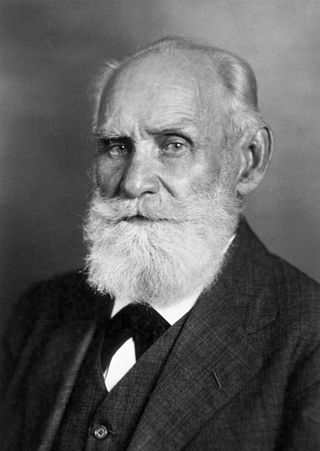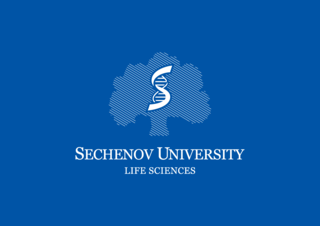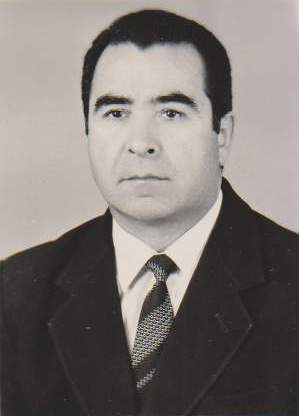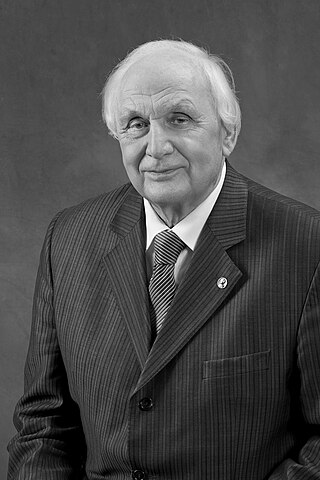
Ivan Petrovich Pavlov was a Russian and Soviet experimental neurologist and physiologist known for his discovery of classical conditioning through his experiments with dogs.

The Russian Academy of Sciences consists of the national academy of Russia; a network of scientific research institutes from across the Russian Federation; and additional scientific and social units such as libraries, publishing units, and hospitals.
The Keldysh Institute of Applied Mathematics is a research institute specializing in computational mathematics. It was established to solve computational tasks related to government programs of nuclear and fusion energy, space research and missile technology. The Institute is a part of the Department of Mathematical Sciences of the Russian Academy of Sciences. The main direction of activity of the institute is the use of computer technology to solve complex scientific and technical issues of practical importance. Since 2016, the development of mathematical and computational methods for biological research, as well as a direct solution to the problems of computational biology with the use of such methods, has also been included in the circle of scientific activities of the institute.

The Academy of Sciences of the Soviet Union was the highest scientific institution of the Soviet Union from 1925 to 1991. It united the country's leading scientists and was subordinated directly to the Council of Ministers of the Soviet Union.
Pyotr Kuzmich Anokhin was a Soviet and Russian biologist and physiologist, known for his theory of functional systems and the concept of systemogenesis. He made important contributions to cybernetics and psychophysiology. His pioneering concept on feedback was published in 1935.

Professor Olga S. Vinogradova (1929–2001) was a specialist in Russian cognitive neuroscience. In 1969 she founded the Laboratory of Systemic Organization of Neurons in the Institute of Biological Physics, Russian Academy of Sciences (Pushchino) and headed this Laboratory till the end of her life.

Ivan Mikhaylovich Sechenov was a Russian psychologist, physiologist, and medical scientist.

First Moscow State Medical University ; Russian: Первый Московский государственный медицинский университет имени И. М. Сеченова) is the oldest medical university in Russia, located in Moscow.
Natalia Petrovna Bekhtereva was a Soviet and Russian neuroscientist and psychologist who developed neurophysiological approaches to psychology, such as measuring the impulse activity of human neurons. She was a participant in the documentary films The Call of the Abyss and Storm of Consciousness, which aroused wide public interest. Candidate of Biological Sciences, Doctor of Medicine, Full Professor.

Moscow State University of Fine Chemical Technologies named after M.V. Lomonosov is one of the oldest universities in the country that offer training in a wide range of specialties in the field of chemical technology.
Fyodor Grigoryevich Reshetnikov was a Soviet and Russian physical chemist and metallurgist. Reshetnikov became a corresponding member of the Academy of Sciences of the Soviet Union in 1974, academician of the Russian Academy of Sciences in 1992 and was a three-time recipient of the USSR State Prize.
The Pavlovian session was the joint session of the USSR Academy of Sciences and the USSR Academy of Medical Sciences held on June 28 to July 4, 1950. The session was organized by the Soviet Government headed by Joseph Stalin in order to fight Western influences in Russian physiological sciences. During the session, a number of Ivan Pavlov's former students attacked another group of his students whom they accused of deviating from Pavlov's teaching. As the result of this session, Soviet physiology excluded itself from the international scientific community for many years.

Ivane Beritashvili, was one of the great Georgian physiologists, one of the founders of the modern biobehavioral science. He was a founder and director of a school of physiology in Georgia; academician of the Academy of Sciences of the USSR (1939), founding member of the Academy of Medical Sciences of the USSR (1944) and of the Academy of Sciences of the Georgian SSR (1941). In 1964 Beritashvili received Hero of Socialist Labor award. For more than a half-century of his activity, Beritashvili was considered a leader among neurophysiologists of Central and Eastern European countries and the former Soviet Union. In the study of higher brain functions he tried to bridge the gap between physiology and psychology and did much to bring them closer together. In 1958–1960 together with Herbert Jasper and Henri Gastaut, he was one of the founders of the International Brain Research Organization (IBRO).
Ivan Nikolayevich Nazarov was a Soviet organic chemist.

Khudoyor Yusufbekovich Yusufbekov was a Soviet scientist and organizer of scientific projects and institutes in Pamir. He was a leading scientist who made a significant contribution to the development of biological sciences, whose name is connected with a new direction of the development of plant growing in the arid mountain and highland territory of Pamir-Alay; a prominent specialist in the field of plant growing, plant introduction and pasture economy, meadow studies, phyto-amelioration, and botany, Yusufbekov was a practicing field researcher, figure of higher education, and professor. In 1968, he developed a system for fodder improvement in the Pamir and Alay valleys that was differentiated from the perspective of the ecological and geographical areas and high-altitude zones. He also implemented a system of arid fodder, and proposed methods of cultivation of useful plants in the Pamir area in 1972. In 1970—1975, Khudoyor Yusufbekov developed the master plan of reconstruction of the Pamir Botanical Garden. In 1969, he became doctor of the agricultural sciences. In 1976, he became an Academician of the Academy of Sciences of the Tajik Soviet Socialist Republic. In 1962—1969, he was the director of the Pamir Biological Station; at the same time in 1965—1990, he was the Chairman of the Bureau of the Pamir Base; in 1969—1981, the director of the Pamir Biological Institute of the Academy of Sciences of the Tajik SSR; in 1981—1986, the rector of the Tajik Agricultural Institute of the Ministry of Agriculture of the USSR; in 1986—1990, the Academician Secretary of the Biological Department of the Academy of Sciences of the Tajik SSR. From 1989, he was a Member of the Presidium of Academy of Sciences of the Tajik SSR. Moreover, he was a state and public figure, the head of the scientific council of the department of biological science of the Academy of Sciences of the Tajik SSR and a Member of the coordination council of the department of general biology of the Academy of Sciences of the USSR (1987—1990). He was also a fellow of the Geographical Society of the USSR since 1965, Member of the All-Union and Central Asian Councils of the Botanical Gardens of the USSR (1972—1990), Member of the Council on the "Biological Foundations of the Rational Use and Protection of Flora" of the Academy of Sciences of the USSR (1976—1990), Member of the Council on the "Biological Foundations of the Development of Mountain Territories in Central Asia" (1975—1990), Member of the Council of the All-Union Botanical Society (1976—1990).

Vladimir Aleksandrovich Ilyin was a Soviet and Russian mathematician, Professor at Moscow State University, Doctor of Science, Academician of the Russian Academy of Sciences who made significant contributions to the theory of differential equations, the spectral theory of differential operators, and mathematical modeling.

Andrei Viktorovich Gaponov-Grekhov was a Russian (Soviet) physicist, a Full Member of the USSR Academy of Sciences, the founder of the Institute of Applied Physics in Nizhny Novgorod, and its first director in 1976-2003.

Anatoly Alekseyevich Dorodnitsyn 19 November, 2 December, 1910 – 7 June 1994, Moscow) was a Russian mathematician who worked as an engineer in the former Soviet space program.

The Kharkiv State Academy of Design and Arts or KSADA is a state institution of higher education in the field of Art (Design), subordinate to the Ministry of Culture and Information Policy of Ukraine and located in Kharkiv.

Vladimir Ivanovich Picheta was a Belarusian and Soviet historian, first rector of the Belarusian State University, academician of the Academy of Sciences of the BSSR since 1928, Honorary Professor of the BSSR (1926), Corresponding Member of the Academy of Sciences of the Soviet Union since 1939, Academician of the Academy of Sciences of the Soviet Union since 1946.












